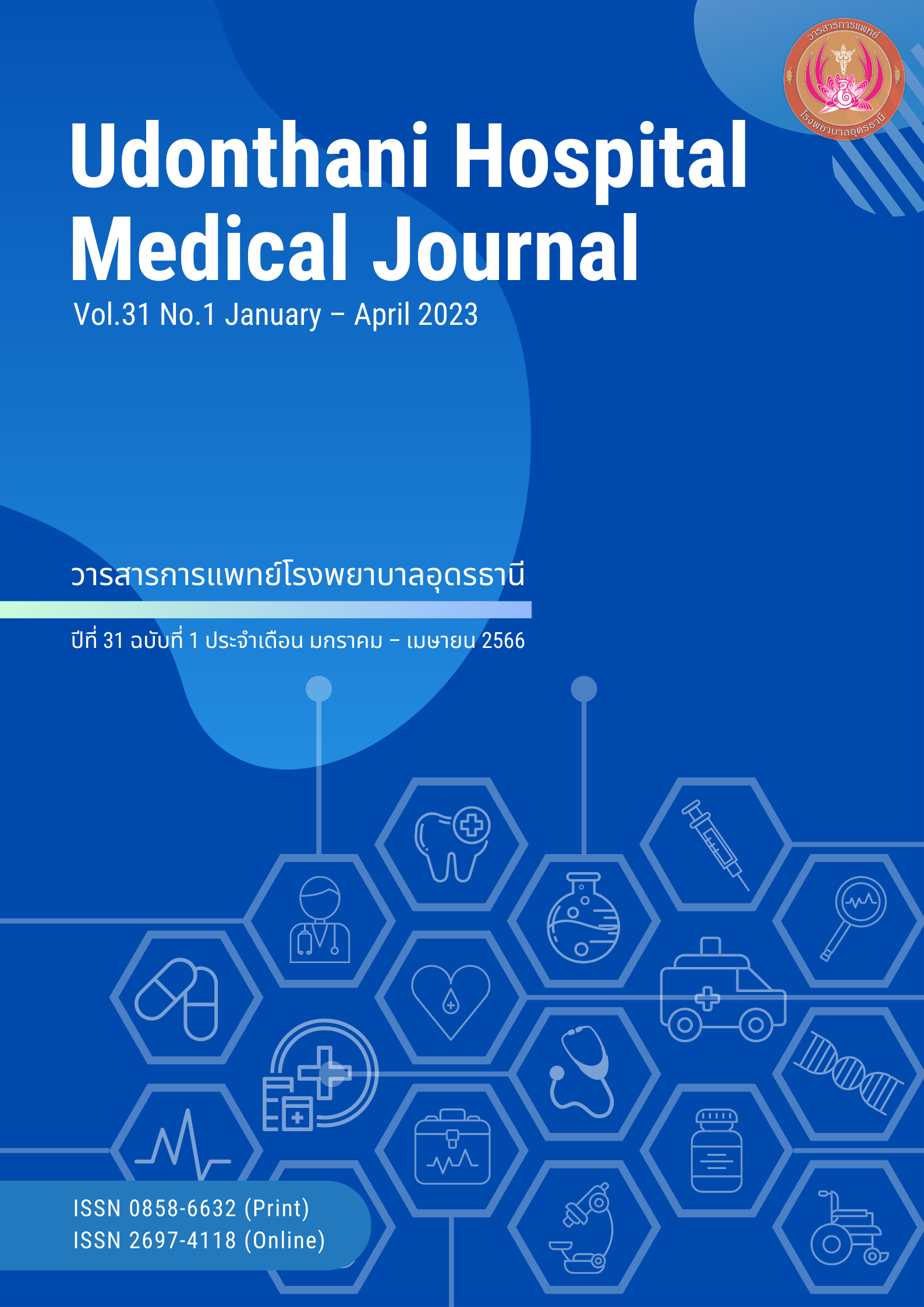การจัดการกับฟันที่หายไปเนื่องจากอุบัติเหตุโดยการใส่รากฟันเทียมในกระดูกขากรรไกรบนด้านหน้า; รายงานผู้ป่วย
คำสำคัญ:
ความวิการของสันเหงือก, รากฟันเทียม, การปลูกกระดูกเพื่อเพิ่มความหนาบทคัดย่อ
การบาดเจ็บบริเวณใบหน้าที่ซับซ้อนมักสร้างความสูญเสียอย่างมากให้กับผู้ป่วยและเป็นสาเหตุของการสูญเสียฟันกระดูกและเนื้อเยื่ออ่อนในช่องปากในบริเวณที่ได้รับแรงกระแทกรวมทั้งส่งผลให้เกิดความวิการของสันเหงือก การใส่ฟันทดแทนในผู้ป่วยเหล่านี้มีความยุ่งยากและซับซ้อนเนื่องจากกระดูกและเนื้อเยื่อรองรับฟันเทียมไม่เพียงพอ การทดแทนฟันในขากรรไกรบนด้านหน้าต้องคำนึงถึงปัจจัยด้านความสวยงามและการใช้งานทันตแพทย์ต้องอาศัยองค์ความรู้และประสบการณ์ในการเตรียมกระดูกและเนื้อเยื่อให้เพียงพอและเหมาะสมกับการใส่ฟันเทียม
บทความนี้เป็นรายงานผู้ป่วย ชายไทย อายุ 34 ปี ที่ได้รับอุบัติเหตุบริเวณใบหน้าและขากรรไกรบนด้านหน้าอย่างรุนแรง ได้รับการวินิจฉัยว่ามีความวิการของสันเหงือกบริเวณขากรรไกรบนด้านหน้า ได้รับการบูรณะการใส่ฟันเทียมด้วยการฝังรากเทียมร่วมกับการปลูกกระดูกเพื่อเพิ่มความหนาร่วมกับการใช้แผ่นเยื่อกั้นชนิดมีการละลายตัว ติดตามการรักษา 1 สัปดาห์ และ 6 เดือน แผลหายสนิทดี ไม่พบลักษณะการอักเสบของเนื้อเยื่อจึงดำเนินการเตรียมเหงือกและใส่ฟันเทียมถาวร ติดตามผลการรักษาที่ระยะเวลา 2 ปี พบว่า ผู้ป่วยใช้ฟันเทียมได้ดี ไม่พบการอักเสบของเนื้อเยื่อ รากเทียมติดแน่น โดยรอบมีกระดูกรองรับ
เอกสารอ้างอิง
Teevawat. P, Thanasak C, Suwit S, Natthapong T. The relationship between oral and maxillofacial trauma and traumatic brain injury: a retrospective case-control study. Thai journal of oral and maxillofacial Surgery 2019; 33(2): 88-94.
Ugolini A, Parodi GB, Casali C, Silvestrini-Biavati A, Giacinti F.Work-related traumatic dental injuries: Prevalence, Characteristics and risk factors. Dental Traumatology 2018; 34(1): 36-40.
Seymour DW, Patel M, Carter L, Chan M. The management of traumatic tooth loss with dental implants: part 2. Severe trauma. Br Dent J. 2014 Dec; 217(12): 667-71
Jensen SS. Timing of Implant Placement after Traumatic Dental Injury. J Endod. 2019 Dec; 45(12S): S52-S56.
Roden R.D., Principle of bone grafing. Oral Maxillofac Surg Clin North Am 2010; 22(3): 295-300.
Buser D, Martin WC. Optimizing esthetics for implant restoration in anterior maxilla: anatomic and surgical considerations. International Journal of Oral and Maxillofacial Implants 2004; 19: 43-61.
Marco E, Marie G, Ilias P, Pietro F, Heven V. Timing of implant placement after tooth extraction: immediate, immediate-delayed or delayed implant? A Cochrane systermatic review. Eur J Oral Implantol; 3(3): 189-205.
Schropp L,Isidor F.Timing of implant placement relative to tooth extraction. Journal of Oral Rehabilitation 2008; 35(suppl): 33-43.
Schwartz-Arad D, Levin L. Post-traumatic use of dental implants to rehabilitate anterior maxillary teeth. Dent Tramatol 2004; 13(2): 120-128.
Larsen P, Ghali GE. Guided bone and tissue regeneration. Peterson,s Principles of Oral and Maxillofacial Surgery. Hamilton, Ont: B.C. Decker; 2004. p.234-9.
Wang HL, Boyapati L. “Pass” Principles of predictable bone regeneration. Implant Dentistry 2006; 15(1): 8-17.
Malinin T, Temple H.T., Gary A.K. Bone alloy in dentistry: a review. Dentistry 2014; 23(4): 199.
Wang W, Yeung K.W.K. Bone grafts and biomaterials substitutes for bone defect repair: a review. Bioact Mater 2017; 2(4): 224-247.
Bobbert F.S.L., Zadpoor A.A. Effects of bone substitute architecture and surface properties on cell response, angiogenesis and structure of new bone. J Mater Chem B 2017; 5(31): 6175-6192.
Liu J, Kerns DG. Mechanisms of guided bone regeneration: a review. The Open Dentistry Journal 2014; 16(8): 56-65.
Gold step, Fay. Bone grafts. For Implant Dentistry. Oral Health Group. Dec 2019; 1-29.
Bal A, Dugal R, Shah K, Mudaliar U. Principles of Esthetic evaluation for anterior teeth, Journal of Dental and Medical Sciences 2016; 15(3): 28-38.
ดาวน์โหลด
เผยแพร่แล้ว
รูปแบบการอ้างอิง
ฉบับ
ประเภทบทความ
สัญญาอนุญาต

อนุญาตภายใต้เงื่อนไข Creative Commons Attribution-NonCommercial-NoDerivatives 4.0 International License.
การละเมิดลิขสิทธิ์ถือเป็นความรับผิดชอบของผู้ส่งบทความโดยตรง
ผลงานที่ได้รับการตีพิมพ์ถือเป็นลิขสิทธิ์ของผู้นิพนธ์ ขอสงวนสิทธิ์มิให้นำเนื้อหา ทัศนะ หรือข้อคิดเห็นใด ๆ ของบทความในวารสารไปเผยแพร่ทางการค้าก่อนได้รับอนุญาตจากกองบรรณาธิการ อย่างเป็นลายลักษณ์อักษร



